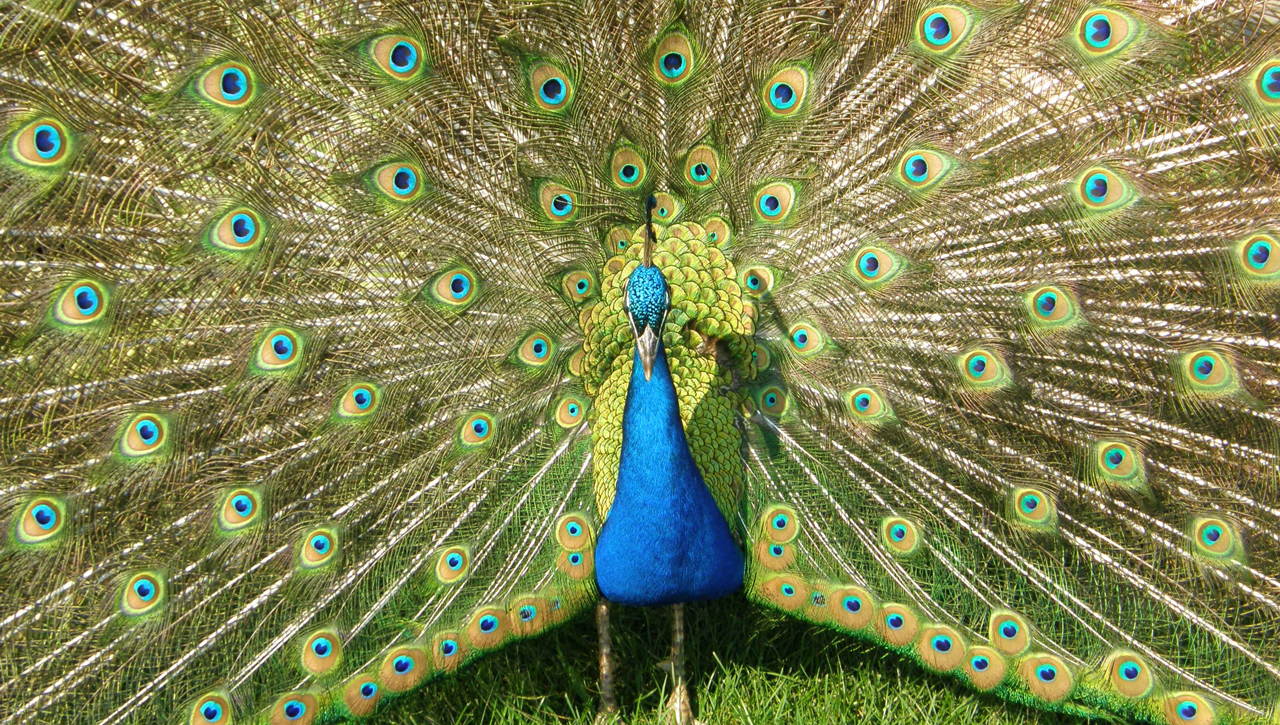Hunger Game: Is Honesty Between Animals Always the Best Policy?

Imagine you’re a puny peacock, rendered weak by bad genes or poor nutrition. You hope to attract a peahen, who mainly cares about the length of your tail. Growing a long tail would greatly enhance your sex appeal, but the encumbrance might prevent you from fleeing a predator that a fitter male could evade (and getting eaten dramatically reduces your chances of mating).
Will evolution program you to be honest, growing a lightweight tail that reflects your true fitness? Or will it have you risk life and limb by cultivating deceptively extravagant plumage?
The best strategy for peacocks — and for other animals when they communicate, from gazelles advertising their agility in front of lions to baby birds begging for worms —can be identified using game theory, the mathematical study of how different decisions affect the outcome of a game. In the evolutionary game, where the goal is producing offspring, rampant dishonesty is not an optimal strategy: If peacock tails are never honest, peahens will simply ignore that feature altogether. But perfect honesty, which was long thought to be the evolutionary strategy of choice, may not be ideal either, as some evidence now indicates.
In a new study, game theorists showed that partial honesty might be the best policy in animal communication. During computer simulations of evolving populations, researchers found that a fixed ratio of honesty to dishonesty sets in, where the “signalers” (peacocks) aren’t completely honest, and the “receivers” (peahens) aren’t completely trusting. “You can actually have a stable situation where you have partially honest communication,” said Kevin Zollman of Carnegie Mellon University, the lead author of the study.
Partial honesty works so well in theory that if biologists are able to observe it in practice among peafowl and other animals, it could replace a long-standing but broken picture of how animal communication works.
“It is an interesting idea supported by a theoretical model, which may be worthwhile to try and apply to the begging behavior of meerkats,” said Marta Manser, a behavioral biologist at the University of Zurich, by email. “However, it is not a straightforward test to do.”
It can be difficult to control for all factors in an animal’s behavior, Manser and other biologists explained, which makes it challenging to test the predictions of the new theory against those of the old one.
For decades, the canonical explanation for how and why animals communicate has been the handicap principle, first proposed by the evolutionary biologist Amotz Zahavi in 1975. According to this principle, all animal signaling comes at a cost, but animals are perfectly honest because the cost of deceit is too high. Puny peacocks, for example, do not grow long tails for the same reason that a poor man does not buy a Maserati: It costs too much. (The poor man risks bankruptcy; the peacock risks death.)
In 1990 the game theorist Alan Grafen proved mathematically that the handicap principle is evolutionarily stable. In a game in which a signal enhances the signalers’ attractiveness as a mate but reduces its viability (as is the case with peacocks’ burdensome tails), an equilibrium between cost and benefit is achieved when all signalers are perfectly honest. At that point, a liar that is introduced into the game — a weak peacock with a long tail, for instance — cannot gain an advantage. Backed by game theory, the handicap principle became “a panacea,” Zollman said. Whenever animals were observed communicating with each other, indicating that their signals were evolutionarily stable, scientists assumed the behavior must exact a cost.
The only problem was, the costs didn’t always exist. “If the handicap principle is true, people thought they should be able to observe the cost of signaling in the various signaling systems observed in nature,” said Michael Lachmann, a theoretical evolutionary biologist at the Max Planck Institute for Evolutionary Anthropology in Germany. “And that hasn’t always panned out.”
Consider a baby bird that wants to grow as big and strong as possible. The chick should beg its parents for food whether it is hungry or not, unless the begging is costly. But careful experiments over the years have revealed that for most bird species, begging is cheap. “It’s easy to do and doesn’t attract predators,” Zollman said.
In Grafen’s signaling game, the low signal cost should lead to runaway begging among chicks, causing this mode of communication to lose meaning and disappear. For cheap signals to be stable, evolution must be playing a different game.
In a 1997 paper, the theoretical biologist Carl Bergstrom and his colleagues identified another conundrum: In order for honesty to be stable, the cost of the signal — even an honest one — has to be so steep that both signalers and receivers would be better off if the signal had never evolved. It is unclear to scientists how this situation might arise. “Simply identifying an evolutionarily stable strategy isn’t enough to tell you whether evolution can actually end up there,” said Bergstrom, of the University of Washington, who also co-authored the new study.
In the January issue of “Proceedings of the Royal Society B,” Zollman, Bergstrom, and Simon Huttegger of the University of California, Irvine, show that a partial-honesty model solves both problems. It is evolutionarily stable for both costly and cheap signals, with an equilibrium point that is reachable in a computer-simulated game.
For peacocks, partial honesty works like this: High-quality males will always grow long tails, but low-quality males will be polymorphic, with some growing long tails and some short. “So if you see a peacock with a long tail, it’s more likely he’s of high quality than low quality, but you’re not sure,” Zollman said. Meanwhile, peahens won’t fall for every long tail that sashays by. “If she sees the long tail, she sometimes chooses to mate with him and sometimes declines.”
Partial honesty works similarly when the signal comes cheap. Hungry chicks will always beg, and not-so-hungry chicks will sometimes beg too. “The parents should sometimes but not always feed a chick that’s begging, and should never feed a chick that isn’t begging,” Zollman said.
It’s a winning strategy in theory, but further research is needed to determine if real-world birds actually use it. Hugh Drummond, a biologist at National Autonomous University of Mexico who studies parent-chick interactions among blue-footed boobies, said parent boobies sometimes ignore intensely begging chicks for up to 20 minutes before suddenly coughing up a morsel, behavior that is seemingly consistent with the partial-honesty model. “But is the parents’ responsiveness capricious?” Drummond asked. “Or are they waiting for food to be sufficiently predigested to be ready for regurgitation?”
Biologists must unravel these subtle interpretations of animal behavior in order to answer larger questions about the evolution of honesty and deceit. “Although predictions of Zollman’s model are superficially clearcut,” Drummond said, “tests of them could get mired in ambiguities.”
This article was reprinted on ScientificAmerican.com.



